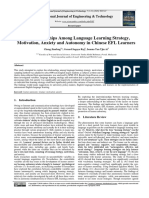Rural Education in India: A Scenario
Rural Education in India: A Scenario
Uploaded by
Anonymous CwJeBCAXpCopyright:
Available Formats
Rural Education in India: A Scenario
Rural Education in India: A Scenario
Uploaded by
Anonymous CwJeBCAXpOriginal Title
Copyright
Available Formats
Share this document
Did you find this document useful?
Is this content inappropriate?
Copyright:
Available Formats
Rural Education in India: A Scenario
Rural Education in India: A Scenario
Uploaded by
Anonymous CwJeBCAXpCopyright:
Available Formats
SRJIS/BIMONTHLY/ DR. NAGAPPA P. SHAHAPUR & DR. OMPRAKASH H. M.
(5268-5272)
RURAL EDUCATION IN INDIA: A SCENARIO
Nagappa P Shahapur1, Ph. D. & Omprakash H M2, Ph. D.
1
Chairman, Dean Dept. of Education Karnataka University Dharwad-580 001, Karnataka
2
Principal SMRS B.Ed and M.Ed College Reshmi Vidhya Bhavan, Kusunoor Road,
Gulbarga-585106, Karnataka
Abstract
India has the largest education system in the world after China. However, issues of Quality education
and access remain challenges in some parts of the Country. The role of education in facilitating social
and economic progress is well accepted. Access to education is critical to access emerging
opportunities that accompany economic growth. Keeping in view of this accepted fact there has been
a major thrust on education since independence, but as far as ensuring quality education in rural
India is concerned it has always been one of the biggest challenges for the governments. Indias rural
areas have been left behind in the wake of high growth in other cities in India. One cause of rural
poverty is the inability for children in rural areas to obtain basic education. India aspires for
universal compulsory primary Education, with its challenges of keeping poor children in school and
maintaining quality of education in rural areas, has been difficult to achieve. It is essential to
convince everyone in rural India that educating himself, children, parents, and even neighborhoods
must be. One way of spreading the education must be encourage every student and share the
knowledge with each other. Here rural education requires special attention to achieve rural
education policy.
Scholarly Research Journal's is licensed Based on a work at www.srjis.com
Introduction: Education is recognized as one of the keys to fighting poverty, but despite the
awareness of that fact too many children in rural India of which is poverty itself which forces
families to put children to work or into other situations because they cannot afford to keep
them at home and in school. In addition, some social customs deny education to girls, and
children who are orphaned are almost always placed in situations that reduce their chances
for education.
Some of the objectives of rural education are as follows.
To serve as a national advocate and representative for rural education at all levels:
Local State Regional National.
MAY-JUNE 2017, VOL- 4/31 www.srjis.com Page 5268
SRJIS/BIMONTHLY/ DR. NAGAPPA P. SHAHAPUR & DR. OMPRAKASH H. M. (5268-5272)
To provide Co-ordination, at the national level, for rural education programs and
activities.
To provide leadership for rural education related conferences and workshops.
To provide a forum for all those involved in public education in rural areas
including teachers, administrators, board members, and members of the rural
community at large whereby they may come together professionally and exchange
ideas.
To promote state, regional and local delivery systems which bring about efficient and
effective education for children in rural areas.
To encourage the collection and dissemination of promising practices, statistical data,
and other appropriate information relating to rural education as well as co-ordinating
the sharing of services and resources among educational organizations and agencies.
To encourage colleges and universities to develop materials and resources specifically
for rural schools and to train personnel to work more effectively in small schools.
To stimulate discussion, research, and policy development regarding equal
educational opportunities for all students.
To stress the need for public or private agencies to develop specific educational
materials and technology appropriate to children in rural areas.
(BRC), Cluster Resource Centers (CRC), and in rural areas, Village Education
Committees (VEC).
Eighty-seven percent of the schools in India are in the countrys villages, government
statistics and independent surveys have revealed that over 90 percent of the rural schools at
elementary level are run by the government.
Present scenario:
Rural education condition in India has been still improving however; the rural schools
have to face a lot of suffering. The schools in rural regions are very few at different for off
places and children residing in one dont prefer traveling, considering it as a waste of their
time and money.
And also education in rural India is plagued by many problems like poor
infrastructure, access difficulties, lack of financial support and poor quality of educators are a
few of the most pressing of problems. The big question, however, is whether enrollment and
attendance is the right barometer for evaluating the progress of rural India education. In the
mad search for numbers, has quality been ignored? Secondly, families in rural India struggle
MAY-JUNE 2017, VOL- 4/31 www.srjis.com Page 5269
SRJIS/BIMONTHLY/ DR. NAGAPPA P. SHAHAPUR & DR. OMPRAKASH H. M. (5268-5272)
to make ends meet. Their low income is hardly enough to cover daily supplies of food and
shelter last alone education. Children are needed to work in fields, which eventually means
that they dropout of school, usually after their primary education. A report by UNICEF
estimates that there is a 40 percentage point difference in attendance rate between primary
(69.4%) and secondary (39.1%) students whose coming from rural area. Also, more children
in the age group of 5-14, whose parents are not educated, seem to be outing to go for word
instead of staying in school (UNICEF report-2011).
Rural Education: Problem faced:
India is home to the largest numbers of illiterate people in the world. The Indian
educational system, especially sectors that rural poor, Continues to be plagued with a host of
enormous problems, so, here made an attempt to mention some of the problems which are
facing in rural area.
Problems of Rural Schools Teachers compensation
School Employees
School Buildings
Technology Funding
Promoting Technology private endowments from private and public
businesses.
Creative found rising by the School district
Showing the problems of Funding Centralize School finance so that the state,
rather than local districts, has the primary responsibility for funding schools.
Base school finding on an explicit assessment of the actual costs of educating
a child.
Urban Education Vs Rural Education:
Some of the comparisons between Urban Education to Rural Education.
Computer education is given high importance in urban areas where as very
few schools in villages give computers training.
School education in urban areas is more advanced especially since there is a
lot of computers aided teaching.
Basic amenities like no drinking waters in providing in some of the schools in
villages.
MAY-JUNE 2017, VOL- 4/31 www.srjis.com Page 5270
SRJIS/BIMONTHLY/ DR. NAGAPPA P. SHAHAPUR & DR. OMPRAKASH H. M. (5268-5272)
Apart from the course curriculum rural schools are not wide to involve
children in other activates like sports, co- curricular activities and
competitions.
Level of education in urban schools is for advanced as compared to the basic
level thought in rural schools.
Recent Scenario of Indias Education Sector: At a Glance
Some of the recent scenarios are as follows.
96.5% of children in the 6 to 14 age group in rural India are enrolled in
school.
71.0 % of these children are enrolled in government schools, 24.3% are
enrolled in private schools.
The proportion of girls (age-11-14) who are still out of school has declined
from 6.8% in 2009 to 5.9 in 2010.
Enrollment in private schools in rural India increased from 21.8% in 2009 to
24.3% in 2010.
Nationally, the percentage of five years olds enrolled in schools increased
form 54.6% in 2009 to 62.8% in 2010.
For rural India as a whole, childrens attendance shows no change over the
period 2007-2010.Attendance remained at around 73% during this period.
(Source: Annual status of education report (ASER) -2010.)
Conclusion:
India has the second largest education system in the world after china. The scale of
operation involved to ensure quality of Education for all in the country is unique and
challenging. At the same time, the nature of problems affecting the education system are so
diverse and often deep rooted that the solution cannot lie in the alternation of any one single
factors it is not about just shortage of money or just shortage of trained teachers or lock of
political will; all these undeniably contribute to the problems, affecting the countrys systems.
Every village is not provided with school which means that students have to go to
other villages to get education. Owing to this parents usually do not send their daughters to
school, leading to a failure in achieving rural education in India. Poverty is another setback,
Government schools are not as good and private schools are expensive. Drop-out rate of the
secondary level is extremely high in Villages .Quality related issues are far powerful than
poverty Education and text books should be made interesting. For rural students textbooks
MAY-JUNE 2017, VOL- 4/31 www.srjis.com Page 5271
SRJIS/BIMONTHLY/ DR. NAGAPPA P. SHAHAPUR & DR. OMPRAKASH H. M. (5268-5272)
related this culture, this traditions and values should also be there so as to create their interest
in studies. There is a different between city and village student not in terms of brain or
development but their initial environment, skills, learning ability availability of infrastructure
and access to different but how it is going to be taught would make the difference.
However, there is a need to look at the entire self of problems and deal with the issue
holistically taking into consideration, the specific contest of different sections of the society.
It will also require a constant and strong central support for policy, Strategy, technical
assistance, and monitoring and evaluation combined with increased decentralization with in
government, stronger public-private partnership, and improved accountability relationship
between the service providers, policy makers, and the target population.
References
http://www.yanta.org/componet/content/article
http://www..bihortimes.in/vewersvoice/2012/Dec
http://www.jagranjosh.com/ogneal-Kniwledge/rural-educational
http://vst.vc/yodates/indias-rural-education-an-oppartinity
http://www.mapxotindia.com/my-india/education/india-needs-education
http://en.wikipedia.org/woki/Rural-education
http://www.couterwoornts
MAY-JUNE 2017, VOL- 4/31 www.srjis.com Page 5272
You might also like
- Question 1 (1 Point)Document44 pagesQuestion 1 (1 Point)milanchabhadiya288No ratings yet
- DiscourseDocument17 pagesDiscourseBesse Tuti AlawiyahNo ratings yet
- Individual Learner DifferencesDocument4 pagesIndividual Learner DifferencesM IsHaq SaremNo ratings yet
- Pearson and Tierney ModelDocument1 pagePearson and Tierney ModelYvonneNo ratings yet
- Check Out My 'Advanced Culture-Fair IQ Test' Results From The IQ Comparison SiteDocument4 pagesCheck Out My 'Advanced Culture-Fair IQ Test' Results From The IQ Comparison SiteMia SercoNo ratings yet
- Difference Between Mmpi and Mmpi 2Document4 pagesDifference Between Mmpi and Mmpi 2api-319067647No ratings yet
- Syllabuses From Grade 9 12 FINAL Version Revised March 2022Document69 pagesSyllabuses From Grade 9 12 FINAL Version Revised March 2022abdimoh7522No ratings yet
- The Challenges Facing Language Policy and Planning in NamibiaDocument3 pagesThe Challenges Facing Language Policy and Planning in NamibiaNick Aston0% (1)
- Course OutlineDocument2 pagesCourse OutlinerabiaNo ratings yet
- Globalization, English Language Policy, and Teacher Agency - Focus On AsiaDocument18 pagesGlobalization, English Language Policy, and Teacher Agency - Focus On AsiabirknerNo ratings yet
- Ferguson's 9 CriteriaDocument3 pagesFerguson's 9 CriteriaAbraham Adejare AdekunleNo ratings yet
- Grammar NotesDocument21 pagesGrammar NotesSuriani DaudNo ratings yet
- CCC Chapter 1 Imperatives - 2Document48 pagesCCC Chapter 1 Imperatives - 2Saram haiderNo ratings yet
- Enhancing Teachers Self-Efficacy: Theoretical and Research ConsiderationsDocument8 pagesEnhancing Teachers Self-Efficacy: Theoretical and Research ConsiderationsDan Gregorious100% (1)
- Curriculum Analysis WorksheetDocument3 pagesCurriculum Analysis WorksheetPauline HornerNo ratings yet
- 5 Stages of Language AcquisitionDocument2 pages5 Stages of Language AcquisitionMuhammadMalek0% (1)
- Critical Discourse Analysis of Pakistan PM Nawaz Sharif Speech in UN General AssemblyDocument9 pagesCritical Discourse Analysis of Pakistan PM Nawaz Sharif Speech in UN General AssemblyJhanzaib KhanNo ratings yet
- ELT4 Principles of SLA and Materials Development King Arjay Calingasan PDFDocument27 pagesELT4 Principles of SLA and Materials Development King Arjay Calingasan PDFBagsit Angelique Khryztelle G.No ratings yet
- Pragmatics and Discourse AnalysisDocument14 pagesPragmatics and Discourse AnalysisDr Abdus SattarNo ratings yet
- Factors Affecting Quality of English Language Teaching and Learning in Secondary Schools in NigeriaDocument13 pagesFactors Affecting Quality of English Language Teaching and Learning in Secondary Schools in NigeriaMirian Xiomara Chavez Zambrano100% (2)
- Lecture in GEd 201 - Lesson 4 Language Planning and Language PolicyDocument2 pagesLecture in GEd 201 - Lesson 4 Language Planning and Language PolicyAnne BautistaNo ratings yet
- 5 Sense Properties, Stereotype, & Sense RelationDocument62 pages5 Sense Properties, Stereotype, & Sense RelationNisaafinaaNo ratings yet
- Main Points of Inter Language, Krashen, andDocument22 pagesMain Points of Inter Language, Krashen, andCikgu MelurNo ratings yet
- Why Use of Literature in The ClassroomDocument23 pagesWhy Use of Literature in The ClassroomSachi pimentelNo ratings yet
- Chapter 2Document4 pagesChapter 2Bayu Christiana AdiNo ratings yet
- Chapter Four and FiveDocument25 pagesChapter Four and Fiveibrahimkulow999No ratings yet
- Introduction To Psychology of Learning - Lecture NotesDocument12 pagesIntroduction To Psychology of Learning - Lecture NotesJulie ClarizaNo ratings yet
- English Across The CurriculumDocument15 pagesEnglish Across The CurriculumJohn Feri Jr.No ratings yet
- Development of Socio-Cultural CompetenceDocument10 pagesDevelopment of Socio-Cultural CompetenceRika SusdimanNo ratings yet
- Using Film Cartoon in Teaching SpeakingDocument5 pagesUsing Film Cartoon in Teaching SpeakingWili De GarfieldNo ratings yet
- Language StandardizationDocument13 pagesLanguage StandardizationaisyahdasopangNo ratings yet
- Teacher Training For Sri Lanka: Prinsett: Charles Parish and Raymond W. BrownDocument7 pagesTeacher Training For Sri Lanka: Prinsett: Charles Parish and Raymond W. BrownBarbara HernandezNo ratings yet
- LESSON 7 The Teacher and The Syllabus Development Designs VIDocument6 pagesLESSON 7 The Teacher and The Syllabus Development Designs VIAnnie Jane SamarNo ratings yet
- Lexical Sematics Vs Phrasal SemanticsDocument1 pageLexical Sematics Vs Phrasal SemanticsSalam MohammadNo ratings yet
- Argumentative Essay - RubricsDocument3 pagesArgumentative Essay - RubricsAsmida Bizz100% (2)
- Evaluation of English Textbook in Pakistan A Case Study of Punjab Textbook For 9th ClassDocument19 pagesEvaluation of English Textbook in Pakistan A Case Study of Punjab Textbook For 9th ClassMadiha ShehryarNo ratings yet
- Advantages of ProbabilityDocument3 pagesAdvantages of Probabilityravindran85No ratings yet
- BRM Unit 2 PPTDocument64 pagesBRM Unit 2 PPTAmol Kare100% (1)
- The Relationships Among Language Learning StrategyDocument5 pagesThe Relationships Among Language Learning StrategyAli BalaNo ratings yet
- Michael West's General List Comparison With Yemeni Crescent Book WordsDocument40 pagesMichael West's General List Comparison With Yemeni Crescent Book WordsRed RedNo ratings yet
- Approaches T Teaching WritingDocument10 pagesApproaches T Teaching WritingWided SassiNo ratings yet
- Reading Comprehension SyllabusDocument13 pagesReading Comprehension SyllabusKoray OruçNo ratings yet
- Language AcquisitionDocument40 pagesLanguage AcquisitionLovelyn MaristelaNo ratings yet
- Research Proposal - Sample 03Document18 pagesResearch Proposal - Sample 03HƯƠNGNo ratings yet
- Week 10: Conclusion: ELT Materials in Use Around The WorldDocument1 pageWeek 10: Conclusion: ELT Materials in Use Around The WorldGhulam Muhammad AbbasiNo ratings yet
- Compare and Contrast The Behaviourist Theory of Language Acquisition and The Nativist Theory of Language AcquisitionDocument1 pageCompare and Contrast The Behaviourist Theory of Language Acquisition and The Nativist Theory of Language AcquisitionAna Mariel V. SaminoNo ratings yet
- Linguistics Quiz-WPS OfficeDocument113 pagesLinguistics Quiz-WPS OfficeAyesha JavedNo ratings yet
- The Impacts and Challenges of Pedagogical Skills IDocument20 pagesThe Impacts and Challenges of Pedagogical Skills ISurya Narayan DasNo ratings yet
- What Is LanguageDocument2 pagesWhat Is LanguageChy Lisondra SacatropezNo ratings yet
- The Progressive and Perfective Aspect: NotesDocument5 pagesThe Progressive and Perfective Aspect: NotesDenisa DrăghicescuNo ratings yet
- Introduction To Linguistics - Final ExamDocument2 pagesIntroduction To Linguistics - Final ExamDom Celestino MartinNo ratings yet
- Transactional - Reader Response TheoryDocument11 pagesTransactional - Reader Response TheoryRangothri Sreenivasa SubramanyamNo ratings yet
- 4 Translation Theories Local Strategies 7 & 8NNDocument18 pages4 Translation Theories Local Strategies 7 & 8NNNoureldin Mohamed Abdelal100% (1)
- Methods of Communication - Verbal and Non-Verbal CommunicationDocument2 pagesMethods of Communication - Verbal and Non-Verbal CommunicationGudeta100% (1)
- Malcolm Coulthard - An Introduction To Discourse Analysis (Applied Linguistics and Language Study) (1985, Addison Wesley Publishing Company)Document5 pagesMalcolm Coulthard - An Introduction To Discourse Analysis (Applied Linguistics and Language Study) (1985, Addison Wesley Publishing Company)ابو محمد100% (1)
- Syllabus DesignDocument5 pagesSyllabus DesignrominaNo ratings yet
- Educational Sociology - Education and Different Society PDFDocument11 pagesEducational Sociology - Education and Different Society PDFFarsha NicholeNo ratings yet
- Does Error Feedback Help Student Writers New Evidence On The ShoDocument24 pagesDoes Error Feedback Help Student Writers New Evidence On The ShoĐỗ Quỳnh Trang100% (1)
- Course: General Methods of Teaching: Code: 8601 Assignment No: 01Document14 pagesCourse: General Methods of Teaching: Code: 8601 Assignment No: 01Maria ShehzadiNo ratings yet
- The Origins of ESPDocument6 pagesThe Origins of ESPZeynabNo ratings yet
- Fostering International Student Success in Higher Education, Second Edition: copublished by TESOL and NAFSAFrom EverandFostering International Student Success in Higher Education, Second Edition: copublished by TESOL and NAFSANo ratings yet
- Rural Children Education ImprovementDocument24 pagesRural Children Education ImprovementdghhhNo ratings yet
- 4.Dr Gagandeep KaurDocument13 pages4.Dr Gagandeep KaurAnonymous CwJeBCAXpNo ratings yet
- 29.yuvraj SutarDocument4 pages29.yuvraj SutarAnonymous CwJeBCAXpNo ratings yet
- 25.suresh ChenuDocument9 pages25.suresh ChenuAnonymous CwJeBCAXpNo ratings yet
- 19.Dr Ibrahim Aliyu ShehuDocument29 pages19.Dr Ibrahim Aliyu ShehuAnonymous CwJeBCAXpNo ratings yet
- Sociological Gaze of Tare Zameen ParDocument4 pagesSociological Gaze of Tare Zameen ParAnonymous CwJeBCAXpNo ratings yet
- Investigation of The Satus of The Social Development Programs Under Sansad Adarsh Gram Yojana in Rajgoli Village in Kolhapur DistrictDocument12 pagesInvestigation of The Satus of The Social Development Programs Under Sansad Adarsh Gram Yojana in Rajgoli Village in Kolhapur DistrictAnonymous CwJeBCAXpNo ratings yet
- 1.prof. Ajay Kumar AttriDocument8 pages1.prof. Ajay Kumar AttriAnonymous CwJeBCAXpNo ratings yet
- Homesh RaniDocument7 pagesHomesh RaniAnonymous CwJeBCAXpNo ratings yet
- An Analysis of The Rights and Duties of Parents Towards Their Children Under Islamic Law in NigeriaDocument29 pagesAn Analysis of The Rights and Duties of Parents Towards Their Children Under Islamic Law in NigeriaAnonymous CwJeBCAXpNo ratings yet
- Customers' Consciousness About Financial Cyber Frauds in Electronic Banking: An Indian Perspective With Special Reference To Mumbai CityDocument13 pagesCustomers' Consciousness About Financial Cyber Frauds in Electronic Banking: An Indian Perspective With Special Reference To Mumbai CityAnonymous CwJeBCAXpNo ratings yet
- 13.nasir RasheedDocument9 pages13.nasir RasheedAnonymous CwJeBCAXpNo ratings yet
- Financial Concerns and Requirements of Women EntrepreneursDocument10 pagesFinancial Concerns and Requirements of Women EntrepreneursAnonymous CwJeBCAXpNo ratings yet
- Technostress, Computer Self-Efficacy and Perceived Organizational Support Among Secondary School Teachers: Difference in Type of School, Gender and AgeDocument13 pagesTechnostress, Computer Self-Efficacy and Perceived Organizational Support Among Secondary School Teachers: Difference in Type of School, Gender and AgeAnonymous CwJeBCAXpNo ratings yet
- Aggression Among Senior Secondary School Students in Relation To Their Residential BackgroundDocument8 pagesAggression Among Senior Secondary School Students in Relation To Their Residential BackgroundAnonymous CwJeBCAXpNo ratings yet
- Critical Analysis of Depression Among Higher Education Students of KolkataDocument12 pagesCritical Analysis of Depression Among Higher Education Students of KolkataAnonymous CwJeBCAXpNo ratings yet
- Context of Eco-Psychological ImbalanceDocument8 pagesContext of Eco-Psychological ImbalanceAnonymous CwJeBCAXpNo ratings yet
- Exploitation of The Ones Who Have No OneDocument15 pagesExploitation of The Ones Who Have No OneAnonymous CwJeBCAXpNo ratings yet
- A Study On Pre-Investment Due Diligence by Capital Market Investors of Mumbai Suburban AreaDocument11 pagesA Study On Pre-Investment Due Diligence by Capital Market Investors of Mumbai Suburban AreaAnonymous CwJeBCAXpNo ratings yet
- A Study of Awareness About Online Information Resources of Student TeachersDocument7 pagesA Study of Awareness About Online Information Resources of Student TeachersAnonymous CwJeBCAXpNo ratings yet
- The Need of Remote Voting Machine in Indian Voting SystemDocument7 pagesThe Need of Remote Voting Machine in Indian Voting SystemAnonymous CwJeBCAXpNo ratings yet
- Historical Development of Play Schools in IndiaDocument11 pagesHistorical Development of Play Schools in IndiaAnonymous CwJeBCAXpNo ratings yet
- Empowerment and Education of Tribal Women in IndiaDocument12 pagesEmpowerment and Education of Tribal Women in IndiaAnonymous CwJeBCAXpNo ratings yet
- The Impact of Mindfulness Exercise To Change The Body and MindDocument8 pagesThe Impact of Mindfulness Exercise To Change The Body and MindAnonymous CwJeBCAXpNo ratings yet
- Nep 2020: Analysis On Use of Technology and Its Integration in EducationDocument6 pagesNep 2020: Analysis On Use of Technology and Its Integration in EducationAnonymous CwJeBCAXpNo ratings yet
- Effect of Life Skill Training On Mental Health Among B.ed. Interns in Relation To Their Impulsive BehaviourDocument9 pagesEffect of Life Skill Training On Mental Health Among B.ed. Interns in Relation To Their Impulsive BehaviourAnonymous CwJeBCAXpNo ratings yet
- The Use of English Language During PandemicDocument7 pagesThe Use of English Language During PandemicAnonymous CwJeBCAXpNo ratings yet
- 31 Dr. Suman Kumari, Prof. Sudarshana Rana & Ms. Anita VermaDocument9 pages31 Dr. Suman Kumari, Prof. Sudarshana Rana & Ms. Anita VermaAnonymous CwJeBCAXpNo ratings yet
- 29 Balwinder SinghDocument8 pages29 Balwinder SinghAnonymous CwJeBCAXpNo ratings yet
- Women Empowerment and Religion's Role in Gender Relations in KargilDocument10 pagesWomen Empowerment and Religion's Role in Gender Relations in KargilAnonymous CwJeBCAXpNo ratings yet
- 30 Trishala BhaskarDocument7 pages30 Trishala BhaskarAnonymous CwJeBCAXpNo ratings yet
- Weather Forecasting - Introduction: - Weather Affects Nearly Everyone Nearly Every Day - Weather Forecasts Are IssuedDocument21 pagesWeather Forecasting - Introduction: - Weather Affects Nearly Everyone Nearly Every Day - Weather Forecasts Are IssuedNiño MartinezNo ratings yet
- FINANCE MANAGEMENT FIN420chp 1Document10 pagesFINANCE MANAGEMENT FIN420chp 1Yanty IbrahimNo ratings yet
- Understanding The CAA, 2019 Through A Rights-Based AnalysisDocument4 pagesUnderstanding The CAA, 2019 Through A Rights-Based AnalysisDhriti GoyalNo ratings yet
- UNIPORT Post UTME Past Questions For Arts Social and Management ScienceDocument47 pagesUNIPORT Post UTME Past Questions For Arts Social and Management ScienceNzekwe ChideraNo ratings yet
- 07 Multinational Financial ManagementDocument61 pages07 Multinational Financial Managementeunjijung100% (1)
- Tan Tek Beng Vs David PDFDocument6 pagesTan Tek Beng Vs David PDFNami2mititNo ratings yet
- Concrete Family Quality ControlDocument9 pagesConcrete Family Quality ControlDejana AnaNo ratings yet
- Ecologism and The Politics of Sensibilities: Andrew HeywoodDocument6 pagesEcologism and The Politics of Sensibilities: Andrew HeywoodVer Madrona Jr.No ratings yet
- Inchange Semiconductor BU2508AF DatasheetDocument3 pagesInchange Semiconductor BU2508AF DatasheetEduardo BustosNo ratings yet
- Real Friends: Camila Cabello Ft. Swae LeeDocument5 pagesReal Friends: Camila Cabello Ft. Swae LeeRahmawati KharismaNo ratings yet
- Software Engineering Chapter 1Document31 pagesSoftware Engineering Chapter 1nitin guptaNo ratings yet
- Spare The Rod and Spoil The Child EssayDocument7 pagesSpare The Rod and Spoil The Child Essayafabidbyx100% (2)
- LABMAN 1-2.1: Management ProcessDocument5 pagesLABMAN 1-2.1: Management ProcessAlondra SagarioNo ratings yet
- Hapag Lloyd: Internship ReportDocument18 pagesHapag Lloyd: Internship ReportTara Tabbassum JohnNo ratings yet
- Ucv Trux Level 6Document11 pagesUcv Trux Level 6Romina Rodrigues LozanoNo ratings yet
- ASCE702WDocument40 pagesASCE702WMadhubalan AlagarNo ratings yet
- 6Document21 pages6Apple GenesisNo ratings yet
- Ministries & Offices Archdiocese of Mobile Mobile, ALDocument1 pageMinistries & Offices Archdiocese of Mobile Mobile, ALjsmoore588No ratings yet
- Lion ChasersDocument7 pagesLion ChasersUbacus AlphonseNo ratings yet
- BabyDocument2 pagesBabyJanea ArinyaNo ratings yet
- Lateral Violence in NursingDocument17 pagesLateral Violence in NursingbobNo ratings yet
- Gamified Teaching and Learning Chapter SamplerDocument169 pagesGamified Teaching and Learning Chapter SamplerDavid KNOXNo ratings yet
- People Vs BalibayDocument9 pagesPeople Vs BalibayFord OsipNo ratings yet
- Nuru 342 - Critical Care and RenalDocument4 pagesNuru 342 - Critical Care and RenalIshak IshakNo ratings yet
- Institución Educativa Centro Social Trabajo, Ciencia y Fe: Actividad de Entrada O InicioDocument3 pagesInstitución Educativa Centro Social Trabajo, Ciencia y Fe: Actividad de Entrada O InicioGuery Ludh Piñeros GutierrezNo ratings yet
- Comptia ChartDocument7 pagesComptia ChartOSU92No ratings yet
- Questions PDFDocument106 pagesQuestions PDFPhani Indra100% (1)























































































































